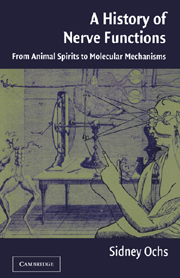Book contents
- Frontmatter
- Contents
- Preface
- 1 Introduction: Greek Science and the Recognition of Nerve as a Channel
- 2 Galen's Physiology of the Nervous System
- 3 Nerve, Brain, and Soul in the Middle Ages
- 4 Renaissance and the New Physiology
- 5 New Physical and Chemical Models of Nerve in the Enlightenment
- 6 New Systematizations of Nerve Function in the Enlightenment
- 7 Electricity as the Agent of Nerve Action
- 8 Nerve Fiber Form and Transformation
- 9 Wallerian Degeneration: Early and Late Phases
- 10 Nerve Regeneration
- 11 Characterization of Axoplasmic Transport
- 12 Molecular Models of Transport
- 13 Actions of Neurotoxins and Neuropathic Changes Related to Transport
- 14 Purposeful Reflexes and Instinctive Behavior
- 15 Neural Events Related to Learning and Memory
- 16 Epilogue: With Observations on the Relation of the Nervous System to Mind
- Bibliography
- Index
11 - Characterization of Axoplasmic Transport
Published online by Cambridge University Press: 13 August 2009
- Frontmatter
- Contents
- Preface
- 1 Introduction: Greek Science and the Recognition of Nerve as a Channel
- 2 Galen's Physiology of the Nervous System
- 3 Nerve, Brain, and Soul in the Middle Ages
- 4 Renaissance and the New Physiology
- 5 New Physical and Chemical Models of Nerve in the Enlightenment
- 6 New Systematizations of Nerve Function in the Enlightenment
- 7 Electricity as the Agent of Nerve Action
- 8 Nerve Fiber Form and Transformation
- 9 Wallerian Degeneration: Early and Late Phases
- 10 Nerve Regeneration
- 11 Characterization of Axoplasmic Transport
- 12 Molecular Models of Transport
- 13 Actions of Neurotoxins and Neuropathic Changes Related to Transport
- 14 Purposeful Reflexes and Instinctive Behavior
- 15 Neural Events Related to Learning and Memory
- 16 Epilogue: With Observations on the Relation of the Nervous System to Mind
- Bibliography
- Index
Summary
The ancient concept of animal spirits moving in hollow nerve fibers to account for sensation and motor control was replaced in the Renaissance with such surrogates as a gas, a thin vapor, a fiery fiuid, vibrating particles, and so on, until eventually the nerve impulse was recognized as being electrical in nature. However, this left still unaccounted for the slow onset of Wallerian degeneration appearing a day or so after nerve transection, along with the later slowly developing atrophy of muscles and sensory organs. Some other nerve principle was involved. With the establishment of the neuron doctrine, the question turned on the possibility of the loss of supply of some substance from the nerve cell to its fibers and the tissues innervated, a hormone, an enzyme, or whatever. And, another related question arose, the nature of the mechanism that transports that principle in the fibers.
EARLY HYPOTHESES OF TRANSPORT BASED ON CELL BODY CHANGES
The chromatolysis of cell bodies, loss of Nissl particles staining dark blue with aniline dyes that was seen to follow the transection of its nerve fibers (Chapter 9), drew the attention of Scott to this phenomenon. He found the particles to consist of a “nucleoproteid,” later identified as ribonucleic acid (RNA), having a remarkable resemblance to the granular material present in secretory gland cells, such as those in the fundus of the stomach and pancreas.
Information
- Type
- Chapter
- Information
- A History of Nerve FunctionsFrom Animal Spirits to Molecular Mechanisms, pp. 215 - 262Publisher: Cambridge University PressPrint publication year: 2004
